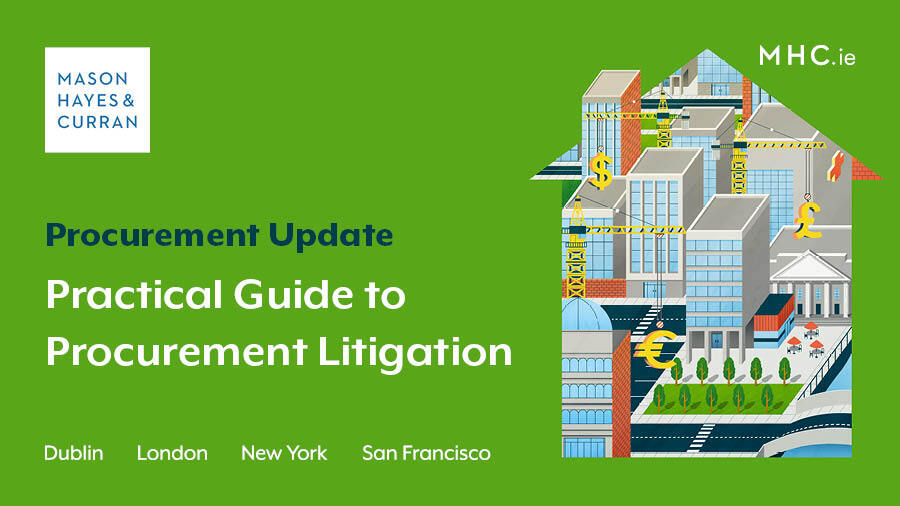Practical Guide to Procurement Challenges

This brief guide provides a practical walk-through of some of the key considerations and steps involved in a public procurement challenge. The guidance is based on the rules under the EU procurement directives and domestic Irish implementing regulations. It is not intended to be an exhaustive guide or legal advice concerning a specific case.
Whether you are a tenderer and suspect there may have been an infringement, or you are a contracting authority and are faced with the prospect of a challenge, our procurement specialists are always available to have an initial consultation.
Remember, though, that time is of the essence in procurement challenges for both parties – though particularly so for would-be challengers. There are strict and very short timelines, so it is important to get legal advice as soon as possible.
Procurement documentation
The procurement documents provide the foundation of any procurement, and tenderers and contracting authorities alike should pay careful attention to the drafting of these documents. Tenderers should make sure that they are happy with the procurement documents when they are first published, i.e. is there is any aspect that is problematic and might infringe procurement rules? If tenderers are unsure, they should seek advice as to whether and how to raise this with the contracting authority and/or to raise a complaint or challenge to the process. Examples of issues tenderers and contracting authorities should look out for include:
- Unclear specifications or requirements
- Discriminatory award or selection criteria
- Favouring the incumbent provider
- Requirements or criteria that are not relevant to the contract
- Equivocal and imprecise review clauses
- Reservation of excessive discretion by the contracting authority
- Use of the wrong procurement procedure
From a tenderer’s perspective, if an issue is identified at this early stage, it is important to raise it, and, if necessary, challenge it, as soon as possible – otherwise, tenderers may be out of time to challenge it later. Contracting authorities should take any issues raised at this stage seriously and use the clarification process as an opportunity to improve and/or fine tune the tender documents. However, care must be taken as certain changes may require an extension of the tender dates or even restarting the procurement process entirely.
The standstill letter
Usually, the first indication that there has been an infringement is the regret letter from the contracting authority informing unsuccessful tenderers that they have been unsuccessful in the tender competition (this is often referred to as the “standstill letter”). This means that care should be taken – both by contracting authorities when drafting the letter and by unsuccessful tenderers when reviewing the letter. The remainder of this guide assumes that this is the starting point.
Does the standstill letter contain all the required information?
You should carefully review the standstill letter to check whether it contains all the required information. In particular, the letter must contain:
- The name of the successful tenderer
- The respective scores of the successful tenderer and your tender
- The characteristics and relative advantages of the successful tender. This is supposed to provide unsuccessful tenderers with a proper understanding of why the successful tenderer scored higher than their tender. If the letter doesn’t cover these aspects, or is too vague and high-level to understand the reasons, then it may be insufficient and non-compliant
- When the standstill period will end
It is worth bearing in mind that, if an unsuccessful tenderer has scored higher on price, there is an extra onus on the authority to properly explain why it lost on quality.
If, as an unsuccessful tenderer, you have concerns as regards the standstill letter, these will need to be raised as soon as possible.
Does the letter indicate any other issues?
Apart from the above deficiencies, the standstill letter may also indicate that there has been a misapplication of the award criteria. For example, the description of why the successful tenderer scored higher on certain award criteria might indicate that the contracting authority’s interpretation and application of those criteria is not what a reasonably well-informed tenderer would have expected them to be.
In other cases, the standstill letter might indicate that the authority has awarded marks for reasons that were not clear from the tender documents – in other words, it has effectively introduced new criteria, or applied undisclosed criteria.
Sometimes, simply disclosing the identity of the preferred bidder for the first time may raise questions – for example, where the unsuccessful tenderer knows that the preferred bidder does not meet some of the selection criteria.
Timing
For both parties, timelines are everything in public procurement litigation. A challenge must be brought within 30 days from the date the challenger knew or ought to have known of the infringement. The courts are very strict with this time limit – it is rarely extended!
In addition, it is important to be aware of when the “standstill period” ends – this will be 14 days beginning the day after the day the standstill letter is sent (assuming the letter is sent electronically).
The standstill period is just as important as the 30-day limitation period. This is because, once the standstill period has passed, the authority can sign the contract with the successful tenderer (even if issues are raised or outstanding). Once the contract has been entered into, the likelihood of a challenger getting the contract set aside, or indeed of obtaining a positive outcome, diminishes significantly.
On the other hand, if proceedings are launched before the contract is signed (e.g. before the standstill period expires), the award of the contract is automatically suspended – in other words, the contracting authority may not sign the contract. This effectively preserves the position until the issue is settled in court, whether by way of an early decision to lift the suspension, or a final decision dismissing the overall challenge.
Launching proceedings
Given the tight timelines, the process of launching proceedings is always going to be pressurised for challengers.
Before launching proceedings, a letter must be sent to the contracting authority indicating the intent to launch proceedings and setting out all of the infringements. For this reason, it is vital that legal advice is sought as soon as issues are identified.
The process of actually launching proceedings involves the preparation of a number of documents setting out the infringements, the facts underlying them, and the claims and reliefs being sought. These formal court documents are:
- A Statement of Grounds, setting out the grounds for the claim and the reliefs being sought
- A Verifying Affidavit, setting out the facts referred to in the Statement of Grounds, and
- A Notice of Motion, alerting the contracting authority to the launch of the proceedings, the reliefs being sought and the first date the matter will appear in court
The contracting authority, in turn, will need to prepare a Statement of Opposition and a Responding Affidavit.
These documents are drafted by counsel but will often require some ‘over and back’ until finalised. The Affidavit will need to be sworn, in the presence of a solicitor or commissioner for oaths, by someone in the challenger’s / contracting authority’s organisation with relevant knowledge of the facts, and the original sworn copy lodged in court. The Affidavit will also append or ‘exhibit’ several documents relevant to the matter, and these need to be collated before, and as part of, the process. These important logistical points need to be borne in mind generally, but also particularly where a party to proceedings is not based in or near Dublin, and where documents will need time to be delivered to Dublin. Once the documents are finalised, they need to be filed in the High Court and then served on the other side (as well as by an unsuccessful tenderer on the successful tenderer).
Remedies and next steps
Once proceedings have been launched and served, this ‘stops the clock’ for the 30-day challenge and automatically suspends the award of the contract (provided it has not already been awarded).
Lifting the automatic suspension
The contracting authority can apply to the court to have this suspension lifted before trial. Such an application is a relatively major undertaking, and the authority may decide that, rather than investing time, effort and cost in seeking to lift the suspension, it is better off defending the proceedings as a whole, and seeking to have them heard and determined at the earliest time.
Whether the court will grant any application to have the suspension lifted will come down to a balancing test. There are a number of key questions the court will consider:
- Is there a serious issue to be tried? (This is a fairly low bar)
- Does the balance of justice lie in lifting or upholding the automatic suspension? (This is an overall balancing test, taking account of all the circumstances and the competing interests of the parties. An important but not decisive factor for this is whether damages would be an adequate remedy which essentially asks whether one or other party can be adequately compensated in damages if it turns out that they are successful at trial)
If the automatic suspension is lifted, the contract may be signed. It is still possible to continue the claim in court and seek damages; however, this is much more difficult. Where the automatic suspension is not lifted, then the trial will likely be expedited (given the need to resolve the issue). The average waiting period for a Commercial Court hearing is currently around 24 weeks.
Remedy of ineffectiveness
In addition, in certain cases, it may be possible to obtain from the court a declaration that the contract is “ineffective”. A declaration of ineffectiveness means that the contract is set aside and all future obligations become unenforceable. It may be available where the contracting authority has gone ahead and awarded the contract without issuing a standstill letter and observing the required standstill period.
There may be cases where the contract was awarded without any procurement procedure at all. In such a situation, there will, naturally, be no standstill letter. Again, the same 30-day time limit will start to run from the date a person knew or ought to have known of the award, and so, from a would-be challenger’s perspective, it is equally important to move quickly.
Conclusion
For both tenderers and contracting authorities, the issues arising in procurement litigation can be multifaceted and nuanced. Given the tight timelines, it is vital to seek expert legal advice as soon as possible.
For more information or an initial consultation, contact a member of our Procurement team.
The content of this article is provided for information purposes only and does not constitute legal or other advice.
Share this:





